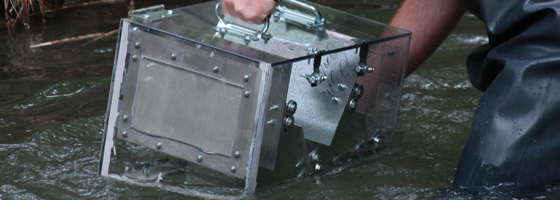Students engineer solution for continuous sediment sampling in Lake Erie tributaries

Pennsylvania Sea Grant ecologists needed a tool for continuous sediment sampling for deployment in local streams. So, they commissioned some engineering students at a nearby college, gave them a tight budget and let their inventive minds do the rest.
“The idea was to have a device that could be installed and left in the stream and, at any time, the sediments collected by the device could be retrieved,” said Sean Rafferty, senior outreach specialist at Pennsylvania Sea Grant. “The sediment would then be sent for chemical analysis. This would allow me to model contaminant inputs to Presque Isle Bay from its tributaries.”
Historic industrial activity and urban runoff led Presque Isle, Pa., on Lake Erie to be listed as an Area of Concern under the Great Lakes Water Quality Agreement in 1991. Sediment trapped heavy metals and tailings from industrial processes as well as other contaminants.
Sediment quality in Presque Isle Bay has since improved. A comprehensive sediment evaluation in 2005 showed no evidence of chemical hotspots and found the sediment was not toxic to aquatic life.
 “Sediment being deposited was cleaner than older sediment, and ecosystem health targets were being met,” Rafferty said.
“Sediment being deposited was cleaner than older sediment, and ecosystem health targets were being met,” Rafferty said.
Cleaner sediment conditions mean an end to a dredging moratorium in the area, which spurred more concern for sediment health. Ecologists, who wanted to ensure the the bay would stay healthy, asked Gannon University students to construct a device that would collect suspended sediment so it could be analyzed for pollutants.
A team of mechanical engineering students took on the project as freshman as part of Gannon’s Scholars of Excellence in Engineering and Computer Science service learning program. “A component of the service is doing a designated community based project,” said Karinna Vernaza, a Gannon mechanical engineering professor.
The students started with a blank slate and a $500 budget. They worked in their spare time for two years to complete a working version. Once a week, they met to discuss designs and ideas. Two designs emerged, which they eventually combined into one.
Sheldon Addis, a junior mechanical engineering student at Gannon, said the team looked at some large-scale sediment samplers for ideas on how to create their mobile version. The students also talked with Gannon professors and scientists from Pennsylvania Sea Grant. They needed a way to slow down and constantly filter water to capture suspended sediment. “We tried to keep it as simple as possible,” Addis said.
The finished product also had to be environmentally friendly, said Erika Schmidt, a junior mechanical engineering student.
 The sampler consists of two Plexiglas boxes with steel baffles inside. One has mesh filters on either end. The other has a mesh filter on one end and a PVC pipe on the other. Each successive mesh filter is finer than the last. A galvanized steel frame holds the boxes.
The sampler consists of two Plexiglas boxes with steel baffles inside. One has mesh filters on either end. The other has a mesh filter on one end and a PVC pipe on the other. Each successive mesh filter is finer than the last. A galvanized steel frame holds the boxes.
Water passes through the box and the baffles slow it down so that it fills the box. The mesh traps suspended sediment. The exit pipe forms a right angle, constricting water as it passes through and ensuring the collector stays full.
A test run in Presque Isle’s Cascade Creek shows a mostly successful design that filters and traps sediment. “We were happy that we came in under our budget and completed the project in two years,” Addis said.
“I think it went well,” Schmidt said. “It did what we expected it to do.”
Rafferty said working with the students was a positive experience. He said the device performed well for all regular stream flow events, but high water in the Cascade Creek from a heavy rain overwhelmed the collector.
“The collection device ultimately was not able to handle the high flow events of Cascade Creek and was damaged,” Rafferty said.
Still, all is not lost. The students will repair and improve collector so it’s ready for the next deployment.
Gannon’s persistent mechanical engineers-to-be are getting their first lesson in real world design, helping with monitoring that will help keep their community and Lake Erie healthy.
Gannon students Erika Schmidt, Sheldon Addis, Stephen Cox, Benjamin Thompson, Nichole McGuire and Sean Herron all contributed to the collection device. Gannon Professors Barry Brinkman, Karinna Vernaza and Theresa Vitolo helped guide students through the process.





0 comments